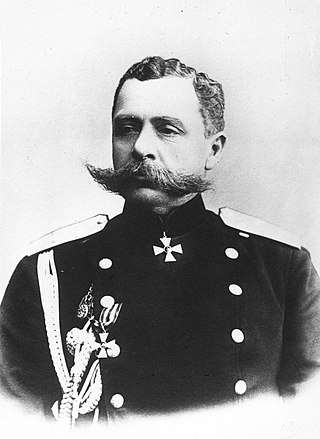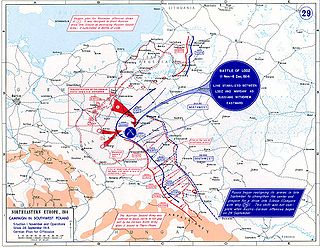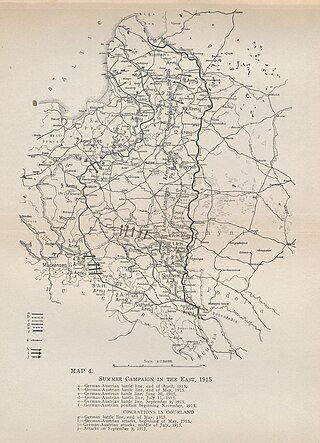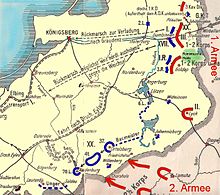
The Battle of Tannenberg, also known as the Second Battle of Tannenberg, was fought between Russia and Germany between 23 and 30 August 1914, the first month of World War I. The battle resulted in the almost complete destruction of the Russian Second Army and the suicide of its commanding general, Alexander Samsonov. A series of follow-up battles destroyed most of the First Army as well and kept the Russians off balance until the spring of 1915.

Hermann Karl Bruno von François was a German General der Infanterie during World War I, and is best known for his key role in several German victories on the Eastern Front in 1914.

The Battle of Stallupönen, fought between Russian and German armies on August 17, 1914, was the opening battle of World War I on the Eastern Front. The Germans under the command of Hermann von François conducted a successful counterattack against four Russian infantry divisions from different infantry corps, which heavily outnumbered them but were separated from each other, creating a gap between the 27th Infantry Division and the 40th Infantry Division, and had little coordination with each other. It was a minor German success, but did little to upset the Russian timetable.

The Battle of Łódź took place from 11 November to 6 December 1914, near the city of Łódź in Poland. It was fought between the German Ninth Army and greatly outnumbered troops of the Russian First, Second, and Fifth Armies, in harsh winter conditions. The Germans redeployed their Ninth Army around Thorn, so as to threaten the Russian northern flank, following German reversals after the Battle of the Vistula River. The German objective was to prevent an invasion of Germany, and thus considered a success, though narrowly avoiding disaster. The battle had a strong impact on both the western and Eastern fronts

Aleksandr Vasilyevich Samsonov was a career officer in the cavalry of the Imperial Russian Army and a general during the Russo-Japanese War and World War I. He was the commander of the Russian Second Army which was surrounded and defeated by the German Eighth Army in the Battle of Tannenberg, one of the early battles of World War I. Ashamed by his loss of the Army, Samsonov committed suicide while retreating from the battlefield.

Paul Georg Edler von Rennenkampf was a Baltic German nobleman, statesman and general of the Imperial Russian Army who commanded the 1st Army in the invasion of East Prussia during the initial stage of the Eastern front of World War I. He also served as the last commander of the Vilna Military District.

The Second Battle of the Masurian Lakes or Winter Battle of the Masurian Lakes, known in Germany as the Winter Battle in Masuria and in Russia as the Battle of Augustowo, was the northern part of the Central Powers' offensive on the Eastern Front in the winter of 1915 during World War I. The offensive was intended to advance beyond the Vistula River and perhaps knock Russia out of the war. It was the last major battle fought on German soil during World War I.

The Battle of the Vistula River, also known as the Battle of Warsaw, was a Russian victory against the German Empire and Austria-Hungary on the Eastern Front during the First World War.

The First Battle of the Masurian Lakes was a German offensive in the Eastern Front 2–16 September 1914, during the Russian invasion of East Prussia. It took place only days after the Battle of Tannenberg where the German Eighth Army encircled and destroyed the Russian Second Army. Using the rapid movements aided by the East Prussian railway network, the Eighth Army reformed in front of the spread-out Russian First Army and pushed them back across their entire front, eventually ejecting it from Germany. Further progress was hampered by the arrival of the Russian Tenth Army on the Germans' right flank.

The Gorlice–Tarnów offensive during World War I was initially conceived as a minor German offensive to relieve Russian pressure on the Austro-Hungarians to their south on the Eastern Front, but resulted in the Central Powers' chief offensive effort of 1915, causing the total collapse of the Russian lines and their retreat far into Russia. The continued series of actions lasted the majority of the campaigning season for 1915, starting in early May and only ending due to bad weather in October.

This is the order of battle for both the Russian and German armies at the Battle of Tannenberg, August 17 to September 2, 1914.

The Battle of Limanowa-Łapanów took place from 1 December to 13 December 1914, between the Austro-Hungarian Army and the Russian Army near the town of Limanowa.

The Russian invasion of East Prussia occurred during World War I, lasting from August to September 1914. As well as being the natural course for the Russian Empire to take upon the declaration of war on the German Empire, it was also an attempt to focus the Imperial German Army on the Eastern Front, as opposed to the Western Front. Despite having an overwhelming superiority over the Germans in numbers, the invading Imperial Russian Army spread its forces thin and was defeated in the battles of Tannenberg and the Masurian Lakes, resulting in a complete strategic collapse of the Russian invasion.

The Battle of Komarow was a battle on the Eastern Front during World War I. It would prove a victory for the Austro-Hungarian forces, but one they would not be able to reproduce in the coming months of the war.

The Great Retreat was a strategic withdrawal and evacuation on the Eastern Front of World War I in 1915. The Imperial Russian Army gave up the salient in Galicia and the Polish Congress Kingdom. The Russian Empire's critically under-equipped military suffered great losses in the Central Powers' July–September summer offensive operations, which led to the Stavka ordering a withdrawal to shorten the front lines and avoid the potential encirclement of large Russian forces in the salient. While the withdrawal itself was relatively well-conducted, it was a severe blow to Russian morale.

The Russian 2nd Army was an army-level command of the Imperial Russian Army in World War I. It was formed just prior to the outbreak of hostilities from the units of Warsaw Military District and was mobilized in August 1914. The army was effectively destroyed at Battle of Tannenberg in August 1914. However, it was rebuilt soon thereafter and fought until almost the end of the war.

The Gorlice breakthrough occurred in the May 1–10, 1915 as part of the Gorlice–Tarnów Offensive during World War I. The German 11th Army led by General August von Mackensen, with the support on the flanks by the 3rd and 4th Austro-Hungarian Armies, defeated the 3rd Russian Army. For the first time in the history of the First World War a heavily fortified and long-term defensive position was broken through during the Gorliсе offensive.

The Carpathian Front, sometimes referred to as the Carpathian Winter War, of 1915 was one of the largest military operations on the Eastern Front at 1915 in terms of scale, duration, the number of troops involved in it and the losses of the parties.

The Bug-Narew Offensive from July 13 to August 27, 1915 was a major German victory during World War I on the Eastern Front. The Imperial German Army broke through 4 heavily fortified positions, inflicted defeats on superior enemy forces and pushed the Russian Army 300 km to the east, capturing 215,000 prisoners. But the German army also suffered relatively heavy casualties, about 30,000 killed and missing.

The Vistula–Bug offensive from July 13 to August 28, 1915, was a major Central Powers offensive with the decisive role of the German Imperial Army during World War I on the Eastern Front to defeat the forces of the Russian army in South Poland and Galicia.

















